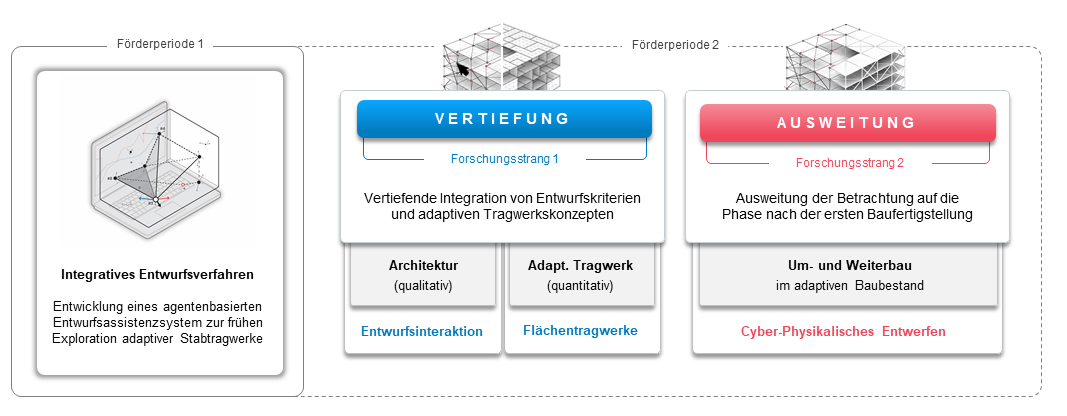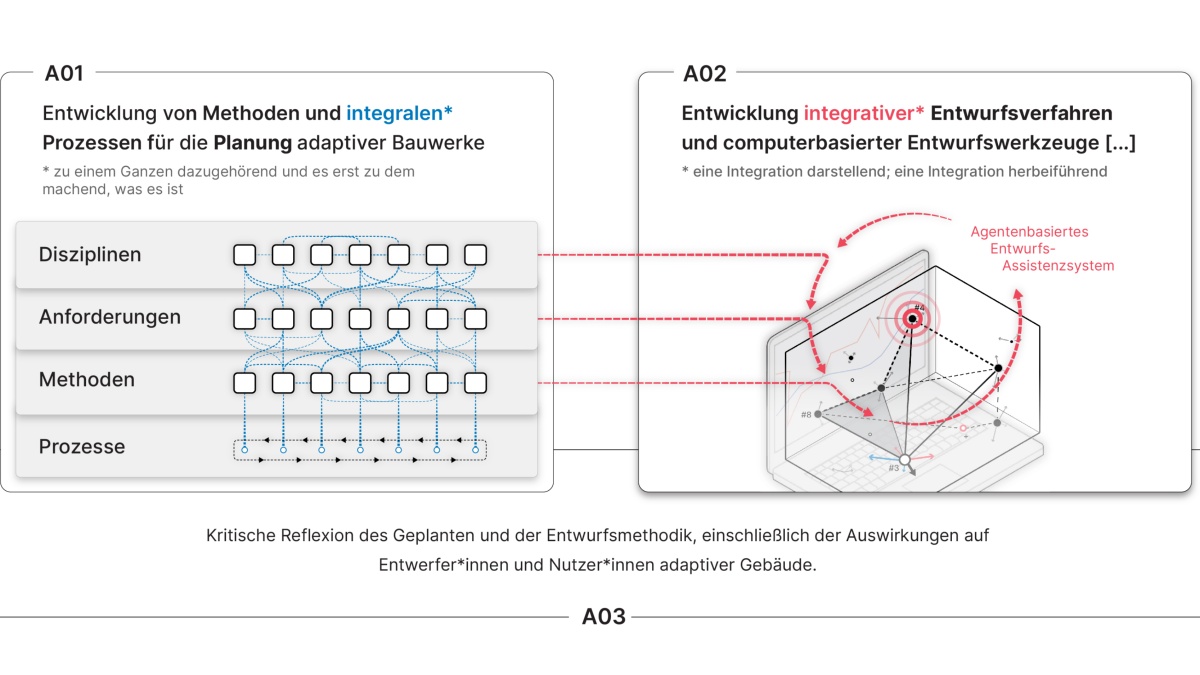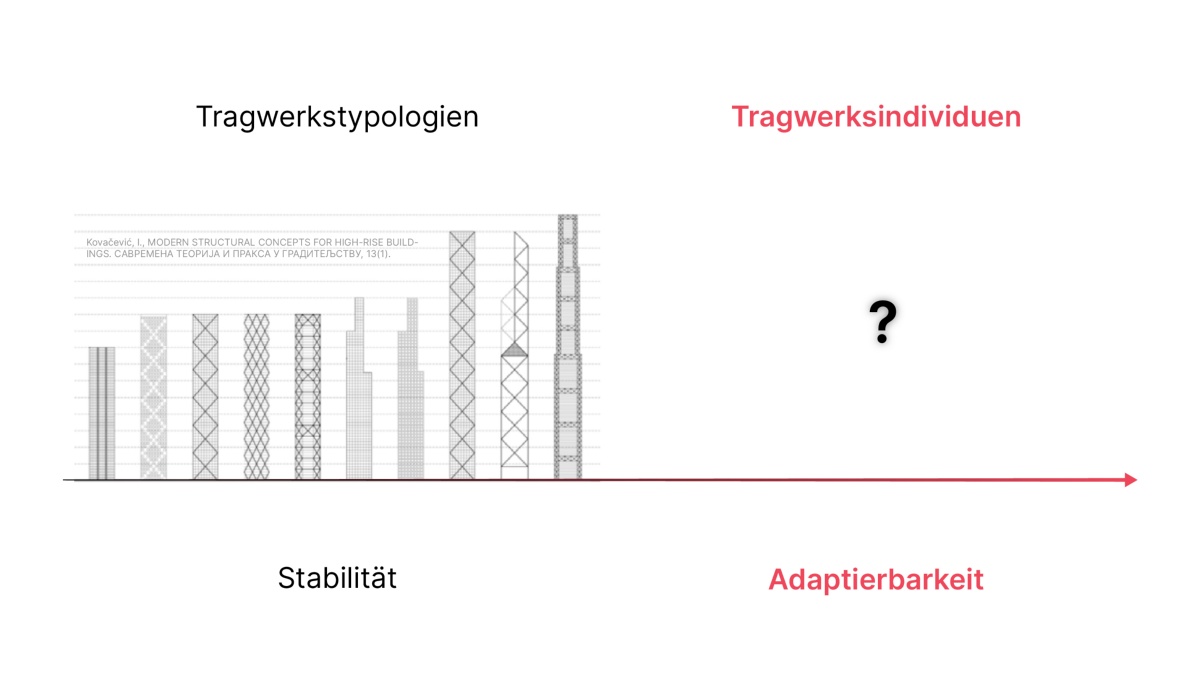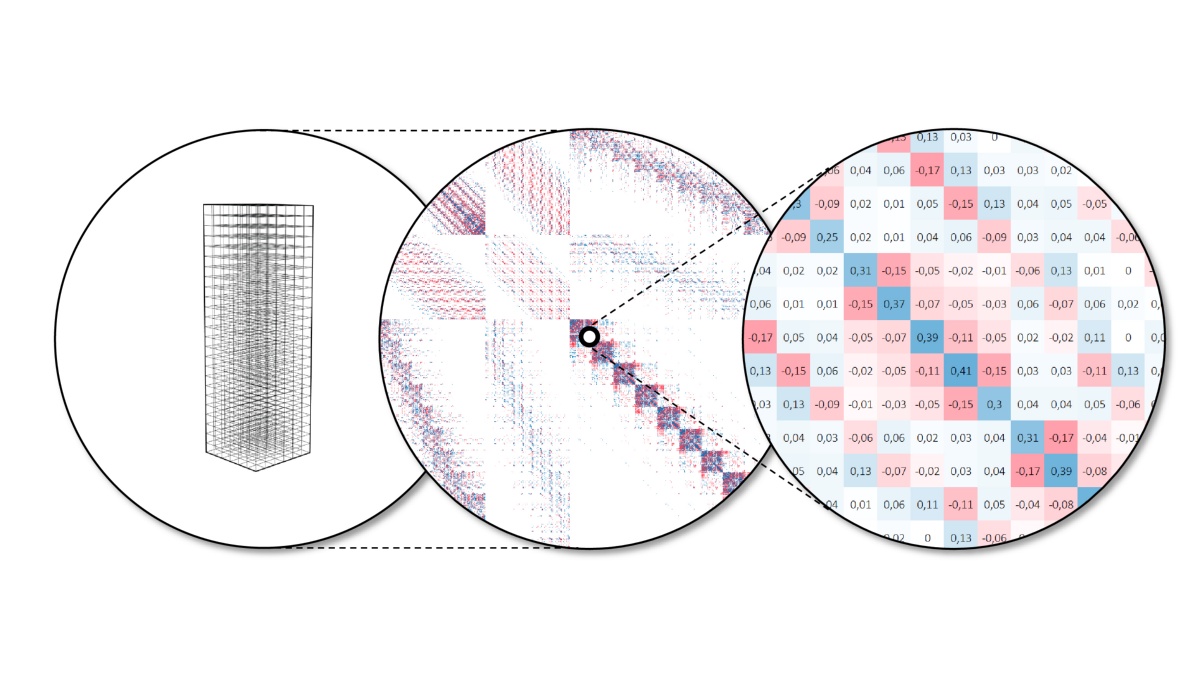Funding Phase II
Project A02 contributes to the interdisciplinary approach of the Collaborative Research Center by investigating the design of adaptive buildings from the perspective of computational architectural design. The aim is to transfer the research results of the overall project and the advantages of adaptivity to architectural practice. The focus is on the development of adequate methods and tools that enable architects to design adaptive buildings in such a way that the complex technical requirements can be incorporated with the greatest possible creativity – allowing them to explore the full architectural and constructive possibilities provided by adaptivity. A02 therefore deals with questions that complement the methodological and interdisciplinary approach in project A01 and the conceptual reflection and projection in project A03.
The following research question will be scientifically investigated in this project:
- Which computational methods and tools are suitable for the integration of the principles of adaptivity and its structural implementation in the pre-design and design phases?
Existing design processes are linear and hierarchical. This makes it difficult to integrate the structural, constructive, building physics, mechanical engineering and mechatronic considerations required for adaptive structures and skins into early design decisions. The existing methods and procedures of architectural design can only be applied to adaptive structures to a limited extent, as they do not address their interdisciplinary character.
The main challenge is therefore to enable integrative design from the very beginning through iterative feedback loops - through which, the findings and results of the disciplines / subprojects involved can be fed back into architectural design explorations. An integrative design process thus provides the basis for the synthesis of architecture- and adaptivity-specific requirements to the essential decision phases of planning.
Based on the developments of funding period 1, two complementary research tracks will be pursued in the second funding period:
The first track aims at further developing previously proposed design methods and tools in view of additional structural and actuation concepts, as well as at strengthening the integration of use- and architecture-specific design criteria. For this purpose, the investigation of adaptive truss structures will be complemented by adaptive surface structures (A04, A06, B01). Analogously, in addition to the successful integration of quantitative aspects, qualitative aspects of architectural design (A03) will be incorporated more extensively. However, this does not mean their mere quantification, but rather their integration through comprehensive strategies of design interaction and visualization (B05).
Throughout the second research strand, studies that have so far focused on the early design stage will be expanded to also investigate the reconfigurability and structural modification of adaptive buildings beyond their initial deployment. To enable the respective "re-design" of future adaptive building stock, research will be focused on the development of cyber-physical architectural design processes (A01, B04, B05) that will allow design changes to be made to already existing adaptive buildings.

Funding Period 2: Deeping and broadening previous research. Photo: ICD
Subproject Leader
- Prof. Dipl. AA (Hons) Achim Menges, Institute for Computational Design and Construction
Funding Phase I
The result of the first funding period is an integrative, computational design process for exploring the architectural solution space of adaptive structures. In view of the peculiarities and complexity of adaptive buildings, an agent-based modeling method was pursued, defined, and implemented for the design of adaptive truss structures. The resulting assistance-system supports architects in early design phases by incorporating the key design criteria for adaptive structures. In order to ensure the adaptability of structure and geometry throughout the entire process, the adaptability assessment method (A04/B01) developed within the SFB 1244 was implemented as a quantitative feedback loop. In addition, application-specific visualization strategies allow a close involvement of designers. These developments form an essential basis for the architectural design of adaptive structures and for the exploration of their architectural potentials beyond conventional structural typologies.
Subproject Leader
- Prof. Dipl. AA (Hons) Achim Menges, Institute for Computational Design and Construction
Publications
- L.-M. Krauß et al., “Baustatische Methoden für Entwurf, Auslegung und Betrieb adaptiver Tragwerke,” in Berichte der Fachtagung Baustatik – Baupraxis 15, 04. und 05. März 2024, Hamburg, B. Oesterle, A. Bögle, W. Weber, and L. Striefler, Eds., 2024, pp. 101–108. doi: 10.15480/882.9247.
- L.-M. Krauß et al., “Berichte der Fachtagung Baustatik – Baupraxis 15 : 04. und 05. März 2024, Hamburg.” Institut für Baustatik, Technische Universität Hamburg, 2024. doi: 10.15480/882.9247.
- X. Yang, A. Lehrecke, C. Tucker, R. Duque Estrada Almeida Araujo, M. Maierhofer, and A. Menges, “Spatial Lacing : A Novel Composite Material System for Fibrous Networks,” in Towards Radical Regeneration : Design Modelling Symposium Berlin 2022, Springer, 2023, pp. 556–568. doi: 10.1007/978-3-031-13249-0_44.
- A. Shad et al., “Assembly-Oriented Design Methodology for Segmented Timber Shells,” in Innovation, Sustainability, Legacy: Proceedings of the IASS 2022 Symposium affiliated with APCS 2022 conference, S.-d. Xue, J.-z. Wu, and G.-j. Sun, Eds., 2022, pp. 1526–1537.
- D. Stieler, T. Schwinn, S. Leder, M. Maiferhofer, F. Kannenberg, and A. Menges, “Agent-based modeling and simulation in architecture,” Automation in contraction, vol. 141, Art. no. 104426, Sep. 2022.
- D. Stieler, T. Schwinn, S. Leder, and M. Maiferhofer, “Agent-based modeling and simulation in architecture,” Automation in contraction, vol. 141, Art. no. 104426, 2022.
- C. Tucker, X. Yang, A. Lehrecke, M. Maierhofer, R. Duque Estrada, and A. Menges, “A Collaborative Multi-robot Platform for the Distributed Fabrication of Three-dimensional Fibrous Networks (Spatial Lacing),” in Proceedings of the 7th Annual ACM Symposium on Computational Fabrication, in SCF ’22. Seattle, WA, USA: Association for Computing Machinery, Oct. 2022, pp. 1–18. doi: 10.1145/3559400.3561995.
- G. Łochnicki, N. Kubail Kalousdian, S. Leder, M. Maierhofer, D. Wood, and A. Menges, “Co-Designing Material-Robot Construction Behaviors: Teaching distributed robotic systems to leverage active bending for light-touch assembly of bamboo bundle structures,” in Realignments: Toward Critical Computation - ACADIA 2021, B. Farahi, B. Bogosian, J. Scott, J. L. García del Castillo y López, K. Dörfler, J. A. Grant, S. Parascho, and V. A. A. Noel, Eds., 2021.
- M. Maierhofer, M. Ulber, M. Mahall, A. Serbest, and A. Menges, “Anthropologic – Architecture and Fabrication in the cognitive age Designing (for) Change Towards adaptivity-specific architectural design for situational open Environments,” eCAADe 38, 2020, pp. 575–584.
- S. Leistner et al., “Research on integral design and planning processes for adaptive buildings,” Architectural Engineering and Design Management, vol. 0, Art. no. 0, 2020, doi: 10.1080/17452007.2020.1856031.
- M. Maierhofer and A. Menges, “Towards integrative design processes and computational design tools for the design space exploration of adaptive architectural structures,” in International Conference on Emerging Technologies In Architectural Design (ICETAD2019), 2019.
Contact

Mathias Maierhofer
M.Sc.Doctoral Researcher







